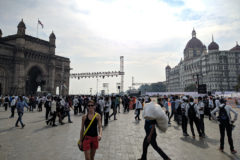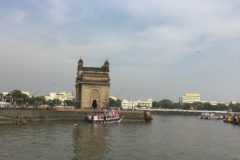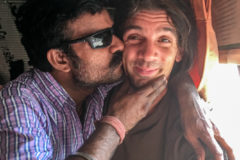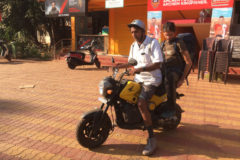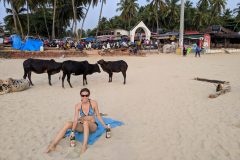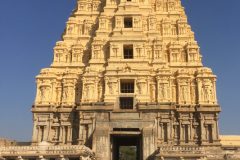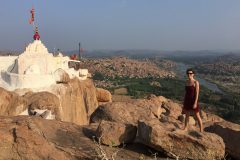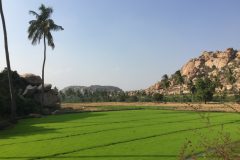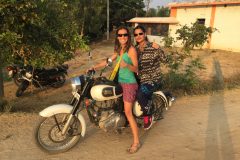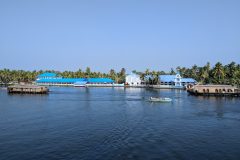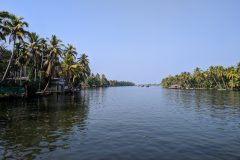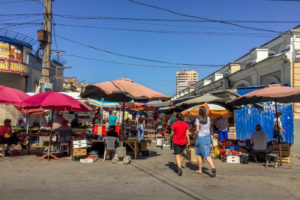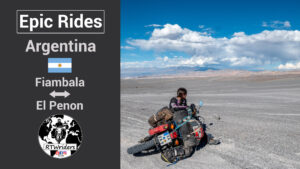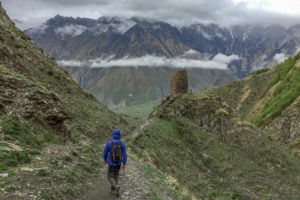In Mumbai’s metropolitan area live around 30 million people. That is rather scaring us and we are not really willing to spend lots of time there. However, we arrive in Mumbai very early in the morning and our next bus isn’t going to leave before the evening. So we decide to take a train to the city centre. Luckily we are able to leave our luggage at a tourist office.
A new metro station is very close, but it is still under construction that time. After the end of the line, we have to take a taxi instead to a real train station to finally reach Churchgate district. It is already a bit chaotic to buy the tickets and we start asking some locals afterwards to find the right platform. The train arrives very quickly and we assure ourselves one more time while entering, if this is really the train to Churchgate. Two people give us the typical Indian head rolling.
Taking a train in India is fun. It is a fast way to travel and you can stand or sit at an open door to watch the landscape. Unfortunately, for long distances you have to book weeks in advance these days. Otherwise you won’t get a ticket anymore, what makes it useless to travel spontaneously. We got told, that there might be some tickets for tourists available very early in the morning at the ticket counters. You still have to be quite lucky though. So we travel by overnight busses most of the time.
After ~20 minutes in the train, a local starts talking to us for a while. In the end he asks us, where we are actually travelling to. “To Churchgate” we answer. “You know, that you are driving in the wrong direction?” – “What! We specifically asked at least 3 persons on the platform, before we entered this train!” – “Maybe, but you are driving in the wrong direction anyway!”. A short check with Miriam’s phone tells us, that this nice man is absolutely right. For God’s sake! What is that fucking head rolling for then? It obviously means something like “yes”, “no”, “no faintest idea” or just “fuck off”.
We say thanks to the friendly guy and leave the train at the next stop to use another one to the right direction. We are a bit grumpy and fail to see buying a new ticket. Everything goes well and after an additional 45 minutes, we finally arrive in Churchgate.
Churchgate is an upper class district in Mumbai. You can get anything your heart desires for prices like back home or even more expensive. We stroll a bit through the district, visit the Gateway of India, a gigantic archway next to the sea, and the Taj Mahal Palace Hotel nearby. Unfortunately, there is a military event happening that day and it is not really possible to visit the monument properly. It is also not that special anyway, so we slowly start to return to the train station. In the evening we take our bus to South Goa.
Goa is India’s party region – so to say India’s answer to Mallorca’s “Ballermann” and most of the reports we heard, sounded rather horrible. Therefore Tobi didn’t visit Goa on his first trip to India on purpose. This time it is on our route anyway and, since lots of locals told us to go there, we decided to give it a try for some days. North Goa is said to be the super party region and in russian hand. South Goa is reputed to be more relaxed. Hence we travel to South Goa, more precisely to Palolem.
We are near Margao, the last stop of our bus trip, very early the next morning. The bus has already become quite empty, since many people got out of the bus earlier. The bus driver’s assistant suddenly rips open our sleeping cabin’s curtain to ask, where we want to drop out. We still have some time before arrival and he seems to be bored. So he jumps into our tiny cabin without further ado or asking for permission. What could be declared as “invasion of privacy” in western countries, is quite common in India – so at that point we are already not wondering anymore. Of course, he hardly speaks any English and we have to communicate with gestures.
He starts asking standard questions – origin, marital status and, needless to say – kids. When he hears, that we are already married for 9 years withoud kids, he starts getting concerned and a bit puzzled. In his opinion there must be something wrong and it definitely has to be discussed. He just seems to ignore the statement, that we don’t want kids. So first he tries to explain us the “basics of making kids” with gestures. The following minutes he starts pointing on Tobi’s “private body parts” and explains, where this has to be put into for success. In the end we are quite happy, when he finally notices, that we are thoroughly familiar with the procedure. After the theory was sorted out, it leads to the conclusion, that there must be a medical issue. Therefore he tries to find out, who is the problematic person and continues to point on Tobi’s genital area. “No medical issue, for God’s sake! – we know how it works – but we don’t want kids and use condoms!”. Suddenly his eyes start gleaming – we are relieved – he probably got it in the end. “Condoms?” – he shakes his head. “No wonder – it doesn’t work like that, of course. You can’t use condoms to make babies!” He is very satisfied now, since he is conviced, that he has solved the problem. We have to promise to try it this evening without prevention and we will see, how easily it works to get a baby. In the meanwhile we gave up to argue with him and hope, that he will leave our cabin soon. So we just say “yes” to everything he proposes to us. We receive about a dozen of kids blessings and Tobi gets hugged and kissed several times to his delight. Then he finally says goodbye and returns to the bus driver. We remain laughing and shaking our heads in disbelief – what a freak show!
We leave the bus quite relieved and find another one, that brings us to Palolem after a short time. From the bus stop to the beach it is around 4 kilometers though. The taxi prices are ridiculous, so we rather decide to walk, what is nice after that long bus journey anyway. At half of the distance, we grab something to eat at a little restaurant. A fairly drunk Indian guy suddenly starts talking to us. Although his condition isn’t the soberst anymore, he seems to be ok and knows a reasonable hostel close to the beach. Unfortunately his motorcycle is only adequate for 2 persons, so I join first and he returns afterwards to give Miri a ride, too. We don’t feel very comfortable, but he insists to bring us to the beach and it is not really like we have a joice.
The hostel is nice and for sunset we meet in one of the beach bars for some more beers – as if he hasn’t had already enough drinks. He originally wants to show us around the next day. However we won’t see him again. Maybe he couldn’t remember it anymore the next morning or he ended up in a ditch?
We spend 3 days in Palolem. At this time it is surprisingly relaxed und luckily there are no parties at all. The beach is not very busy, tolerably clean and nice – at least for a beach in India. A special thing on the beach here, are the sacred cows, that chill out and have a sun bath everywhere. We must be lucky though. Some other tourists will tell us a bit later, that they left Palolem instantly, since the noise and the crowd was unbearable.
All along the beach are many bars that serve alcohol. You can also find a few shops selling alcohol on the main street. One day we buy two beers in one of the shops to enjoy them on the beach. An Indian guy suddenly tells us, that it is forbidden to drink alcohol there. So we rather walk all the way to the end of the beach, where nobody can see us. The next day we relax at the beach close to the main entrance and quite some Indians around us are having a beer. We ask them for a clearing up. “Of course it is allowed!” they reply. So we also buy some beer while checking for prohibition signs one more time.
As we have just opened our beers, the police approaches us. “Alcohol on the beach is forbidden, apart from the beach bars!”. I look around and the Indians are getting fines, too. I ask the officer, how should one know that. “There are signs all over this area”. We tell him, that we couldn’t find a single sign at the beach main entrance. “Believe me, they are everywhere! But – as an exception we’ll only get the lowest ticket with 200 rupees (2,50 €).” We are a bit annoyed, pay for the ticket and start packing up our stuff. The police man asks a bit puzzled, what we are doing there. “Well – leaving the beach. Drinking beer is forbidden here, isn’t it?” – “Sure, but now as you have paid the fine, you can continue drinking beer on the beach for 24 hours. You just have to keep the receipt.”. We look at each other quite flabbergasted – are they completely nuts now? The officer seems to be serious though. It is like it is, or more precisely – it is India, where nothing is normal. So we continue to enjoy our beers on the beach…
When we return to our hostel later, we search for the prohibition signs one more time. There is definitely not a single sign related to alcohol. As we have a closer look at our ticket, we notice, that it is actually a ticket for smoking in public. Please also note the crossed-out “thousand” and the addition “only” on the ticket photo *haha*. These kind of incidents are usually annoying in the beginning, but always a big laughter in the end. And – to be honest – aren’t these bizarre things the reason, why it is so exciting to travel in India?
After some relaxing days on the beach, we take a night bus to Hampi.
When Tobi was in India 15 years ago, Hampi was the reason for him to go there. He saw this region in a movie of the American climber Chris Sharma, called “Pilgrimage”. This time it was only a small village, visited by a few foreigners carrying weird looking beds on their backs (bouldering crash pads). The ancient ruins in that region were often decaying in banana or rice plantations and nobody was really interested in them. Nowdays it has changed a lot. It is full of climbers from all over the world and even Indian tourists have discovered the area as a tourist destination. You can rent bouldering crash pads everywhere and various climbing schools are allover the place. Internet and hotels are available in the whole region. The whole area was declared as a world cultural heritage, the ruins get restored and they start to remove many local houses for archaeological excavations.
There are rumours, that they plan to charge people for the whole region and you have to stay in pricey hotels in Hospet in future. Tourists already have to pay for the major ruins. However the other side of the river, where most of the tourists stay in the meanwhile, is only affected very little so far. It remains to be seen, how it will develop in future. Although Hampi has changed a lot and has become very busy, it is still a magical area. There are white granite boulders allover the landscape as far as the eye can see.
We are lucky, that we arrived 2 weeks before Christmas, since the accomodation prices suddenly triple. Our resort owner assures us, that our price stays the same and we spend 3 unhurried weeks in Hampi. A perfect time to relax, to go climbing, to take a bath in the nearby river or visit the various ruins and temples. Miriam also meets Pia, a cool and funny girl from Mumbai. They have plenty of time to paint the town, explore the area with a motorcycle and have lots of fun together.
In the new year we continue to travel southwards to Alleppey. This area is famous for its backwaters and is also called India’s Venice. Many people describe the state Kerala as a light version of India and we can absolutely agree with that. The people there are not that intrusive, the traffic is less chaotic and the environment seems to be less polluted. You can even walk peacefully without the chance to get overrun, to be forced to buy something or being imposed to take a taxi. Although the description “India’s Venice” is a bit far-fetched, the little canals and villages in the backwaters do look very nice. You can easily explore them with the public boats for almost no money. People, that like it more extravagant, could also hire one of the many house boats. They also offer the possibility to sleep on board. You can easily reckon to pay at least 130€ a day for it, though.
The climate in Kerala is also nicely warm that time of the year. You can wear a t-shirt all day. When we take a return flight to Lucknow mid of january, the temperature suddenly drops to only 8°C (~46°F). Not very surprising, that the sensitive kid (Miri) immediately gets a cold as a start.


